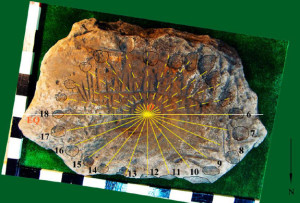Donetsk
Gnomons
Gnomons are the vertical markers of sundials that casts the sun’s shadow. The oldest known sundial is possibly the one found in a burial mound in 2011 near Donetsk in Ukraine(c). Herodotus tells us that the Greeks learned the use of dials from the Chaldeans. The first use of gnomons by the ancient Egyptians is thought to be as early as 3500 BC(d).>Further afield, gnomons were widely used in ancient China(f)(g).<
Gnomons are also used to cast the shadows, by which means latitude can be calculated. Furthermore, the earth’s tilt (obliquity-of-the-ecliptic) may also be calculated using gnomon data and it was this feature that created problems for the Australian astronomer G.F. Dodwell who carried out a study of gnomons around the world over the past 4,000 years. It is generally accepted that the tilt of the earth’s axis varies cyclically between 22 and 24.5° over a period of some 40,000 years due to a number of factors. Dodwell’s difficulty was that his investigations revealed a distinct deviation from the expected, around 2345 BC. The only conclusion that Dodwell could arrive at was that either ancient observations were systematically in error all over the world or the earth’s tilt angle had been altered during historical times.
Dodwell was convinced that this date of 2345 BC was the date of Noah’s Flood when the obliquity-of-the-ecliptic was altered from 5° to its present 23.5°. Although Dodwell was a scientist, he was also fundamentalist in his Christian beliefs. It would appear therefore that his conclusions regarding the date of the Flood may have been an amalgam of his religious views and his scientific investigations.
Amy Smith of Flippin, Arkansas has a website(b) relating to Atlantis in which she highlights two references that indicate a prehistoric change in the earth’s axial tilt, one from the Book of Noah (65.1) and the other from Plato.
Colin Wilson refers[335] to the view of Rand Flem-Ath who maintains that many Mexican temples, which one would expect to be aligned with true north, and in the case of at least 50 of them, are consistently 15.5º adrift of this orientation, providing evidence for the crustal slippage suggested by Charles Hapgood. Although Hapgood proposed a date of 9500 BC for such slippage, long before the present temples were constructed, Wilson points out that religious edifices were frequently erected on the foundations of earlier sacred structures. Many Christian churches have been built astride pagan sites. Whether Rand’s ideas and Dodwell’s discoveries are in any way related, will require further investigation.
The idea of a global catastrophe around 2300 BC has gained support in a number of quarters including advocates such as Moe M. Mandelkehr an ardent catastrophist[337] and Barry Setterfield a dedicated creationist(a). Further support for an axial shift came from Malcolm Bowden of the Creation Science Movement[590].
For those interested in constructing their own gnomon, there are a number of sites giving clear useful instructions(e).
(a) Barry Setterfield Papers (archive.org)
(b) https://old.world-mysteries.com/mpl_10_atlantis_asmith.htm
(c) https://www.livescience.com/40220-album-ancient-bronze-age-sundial.html
(d) http://historyofsciences.blogspot.ie/2015/11/around-3500-bc-ancient-egyptian-develop.html
(e) Horizontal and Vertical Sundials (archive.org)

